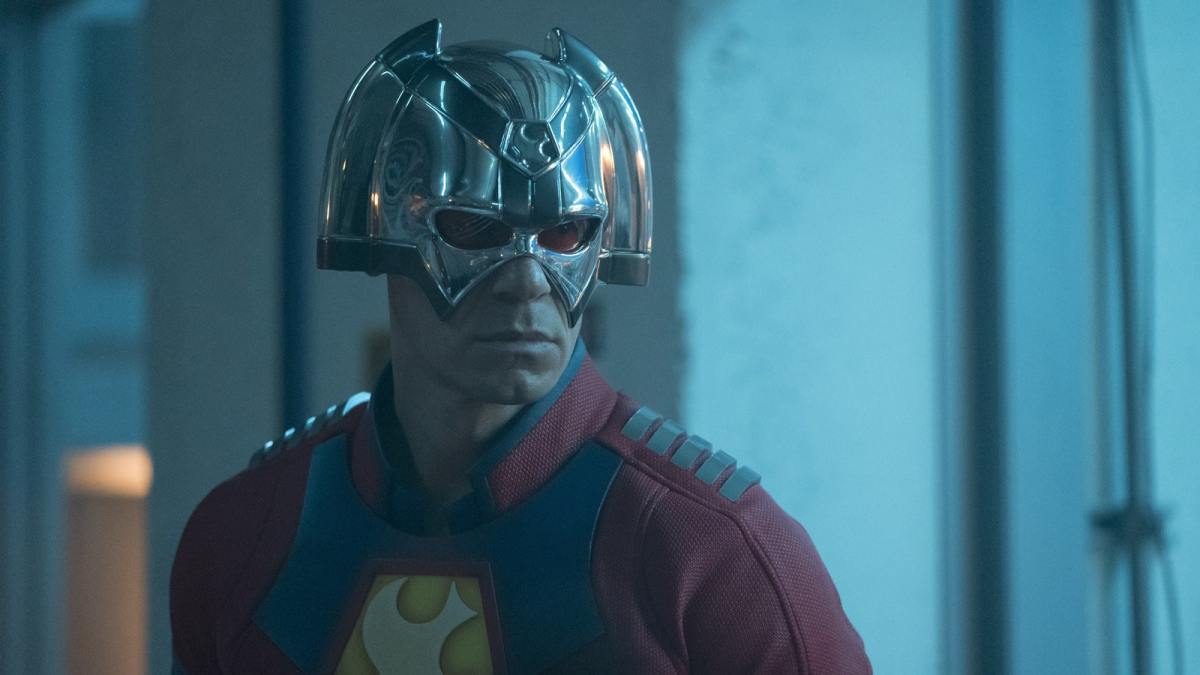This discussion and review of Peacemaker episode 5, “Monkey Dory,” on HBO Max contains some spoilers.
Peacemaker illustrates that perhaps some limitations are better than others. More than that, the superhero streaming series suggests that some limitations offer their own kind of freedom.
Watching Peacemaker, it is clear that the show is operating on a reasonably tight budget, particularly by the standards of the genre. This is particularly obvious when comparing Peacemaker to the film that spawned it, The Suicide Squad. James Gunn’s superhero blockbuster had a reported budget of $185 million, with the production taking the cast and crew to Panama and shooting on “the largest construction project” of any movie in Warner Bros. history.
Meanwhile, Peacemaker was shot in Vancouver. The delightful opening credits sequence was filmed in a high school gymnasium. While Peacemaker does feature impressive computer-generated elements, like Eagly or the Butterflies, these elements tend to feature relatively briefly; Gunn even considered using a real eagle for Eagly. Even the “super-gorilla” in “Monkey Dory” feels more on par with a CW villain than a blockbuster threat.
Gunn has conceded as much. “We had a very good budget on Peacemaker, but it isn’t Suicide Squad,” he told Collider. “And, we didn’t have the time. It was time too.” Peacemaker had to be finished before Gunn was due to begin work on Guardians of the Galaxy Vol. 3, and that informed a lot of his choices in making the series. The entire series was filmed in 131 days, with less than a year between Gunn’s initial rough pitch for the show and the end of production.

This explains certain creative choices. Peacemaker is a very dialogue-driven superhero show, with extended sequences given over to characters bantering back and forth. Many of the series’s post-credit scenes are simply extended cuts of funny conversations from the episode itself. At times, this can become distracting and even frustrating, particularly with characters like Peacemaker (John Cena) and Vigilante (Freddie Stroma) seeming to argue in circles.
“Monkey Dory” openly acknowledges as much, with Clemson Murn (Chukwudi Iwuji) growing impatient as his team’s bickering interrupts an otherwise exposition-heavy briefing scene. “Peacemaker, shut the fuck up,” Murn snaps. “Do you all want to be here ‘til tomorrow?” There’s a real and deliberate sense that Murn is babysitting a set of psychotic school children, and — while it makes sense from a character perspective — it can occasionally be a little much.
Still, Gunn is better at this sort of banter than many of his contemporaries. Even when Peacemaker is spinning its wheels, it can coast on a charming cast and a sharp sense of humor. It helps that Gunn wrote all eight episodes. As such, there’s an impressive consistency to the show, which carries across even the three episodes not directed by Gunn. “Monkey Dory” is directed by Rosemary Rodriguez, even though Gunn reshot the scenes with Vigilante after Stroma was recast, replacing Chris Conrad.
More to the point, the budgetary and production constraints under which Gunn is operating afford the writer and director a great deal of freedom. The more money a studio invests in a project, the more executives with little creative insight tend to get involved. One of the reasons that Amazon moved production of its phenomenally expensive Lord of the Rings television series from New Zealand to the United Kingdom was so executives could visit the set to “monitor” production.

This isn’t an abstract issue, particularly for projects associated with Warner Bros.’ DC brand. Joss Whedon’s studio-mandated reshoots on Justice League remain something of an open wound, with Whedon’s conduct on and off of set continuing to generate discussion. If Whedon’s work and behavior on Justice League are any indication, there is a strong argument for trusting creatives who can work constructively and enthusiastically with their casts in lieu of corporate-dictated synergy.
Gunn has openly discussed the freedom that he enjoyed while filming Peacemaker. Reportedly, the only thing that DC pushed back on in the first four episodes was Peacemaker calling Batman “a pussy.” This makes a certain amount of sense, given how weirdly protective DC can be concerning the overlapping subjects of Batman and female genitalia. Still, when Gunn pushed the point, DC allowed him to keep the joke in the show.
The result of all this is that Peacemaker feels like James Gunn cutting loose. Gunn has spoken about how writing Peacemaker was something that he did “mostly for fun.” There’s a genuine and palpable sense of joy to Peacemaker. While Gunn is a writer and director whose aesthetic shines through even on blockbuster projects like Guardians of the Galaxy and The Suicide Squad, his work feels truly unfettered on Peacemaker.
In some ways, Peacemaker takes Gunn back to his roots. Thematically, the show is an obvious extension of the concepts that bubble through Gunn’s recent blockbuster work, like the interrogation of 1980s masculinity or the focus on abused children trying to escape their parents. However, it is a lot closer aesthetically to Gunn’s earlier low-budget indie projects like Slither and Super. It is remarkable to see that aesthetic at play within the confines of a blockbuster shared universe.

Most obviously, the butterflies feel much closer to the invasive alien parasites in Slither than they do to Starro the Conqueror from The Suicide Squad. The butterflies enter their victim through an orifice and embed themselves in the brain. What follows is something of a blending or hybridization. In Slither, Kylie Strutemyer (Tania Saulnier) gains access to the creatures’ memories during a failed attack. In Peacemaker, the butterflies similarly have access to the memories of the host bodies.
Grant Grant’s (Michael Rooker) possessive attitude to his wife Starla (Elizabeth Banks) in Slither is quite like the hold that Auggie Smith (Robert Patrick) holds over his son. In contrast to Starro’s overt infestation at the climax of The Suicide Squad, secretive butterflies evoke the paranoid science fiction horrors that inspired Slither. “Monkey Dory” even includes a direct shoutout to the iconic closing scene of the Invasion of the Body Snatchers remake, one of Gunn’s favorite horrors.
The costuming and design of characters like Peacemaker and Vigilante hews closer to the grounded aesthetic of the Crimson Bolt (Rainn Wilson) and Boltie (Elliot Page) in Super. There’s an emphasis on how silly these superhero costumes look, particularly when juxtaposed with more mundane surroundings. There are also minimal computer-generated effects used in mapping Peacemaker and Vigilante’s costumes, even compared to Starlord (Chris Pratt) or Bloodsport (Idris Elba).
Indeed, the dynamic between Peacemaker and Vigilante is remarkably similar to that between Crimson Bolt and Boltie in Super. Vigilante insists that he is Peacemaker’s best friend, even if Peacemaker disagrees, just as Boltie basically forces herself into the role of Crimson Bolt’s sidekick. While both Peacemaker and Crimson Bolt have extremely messed up moral compasses, they are contrasted with the more overt psychopathy of both Vigilante and Boltie.

Like both Slither and Super before it, Peacemaker leans into graphic violence. “Monkey Dory” finds Peacemaker blasting people’s heads open with a shotgun. Just a few scenes later, Peacemaker’s face is splattered with blood and gore as Economos (Steve Agee) tears through a butterfly-possessed gorilla using Vigilante’s chainsaw. It’s not quite as graphic as Gunn’s earliest work at exploitation studio Troma, but it’s difficult to imagine anything as schlocky in the Guardians of the Galaxy movies.
To be fair, The Suicide Squad featured similarly graphic violence around characters like King Shark (Agee and Sylvester Stallone) and the Thinker (Peter Capaldi). However, Peacemaker takes more demented glee in the carnage and the blood on display. Due to both its budget constraints and its creative freedom, Peacemaker is less likely to artfully disguise bloodshed in the way that The Suicide Squad did during Harley Quinn’s (Margot Robbie) escape rampage, for example.
None of this is to suggest that Gunn’s work on blockbusters like Guardians of the Galaxy or The Suicide Squad is lacking in personality or is in any way lesser than his work on Peacemaker. Instead, it illustrates that Gunn is a director who understands the level at which he is pitching a given project. Peacemaker has a smaller budget than Gunn’s big blockbuster films and is aimed at a more niche audience. It would be easy to see these as limitations. Peacemaker treats them as opportunities.
More than a decade after Slither and Super, Peacemaker demonstrates that Gunn has retained that punkish indie sensibility through work on two of the biggest franchises of the modern era. In an era where that sort of distinctive identity is often erased or obscured, it is refreshing to know that there’s space for it, even in a shared superhero universe.






Published: Jan 27, 2022 12:00 pm